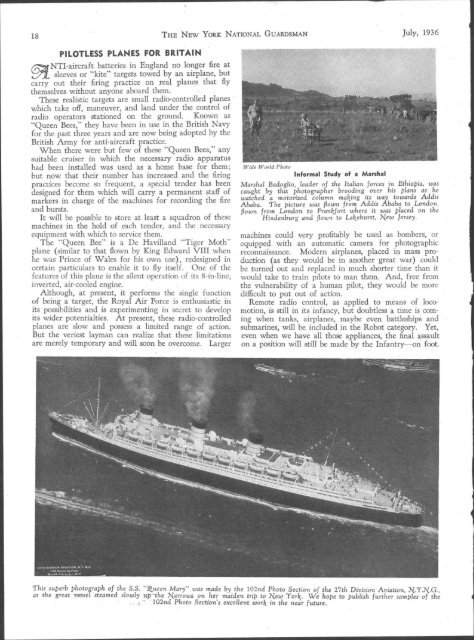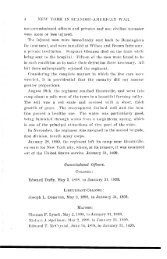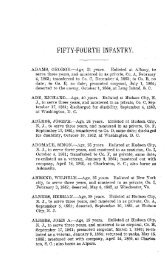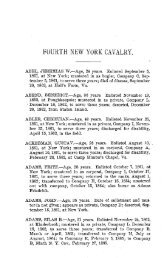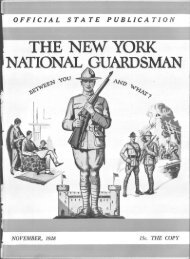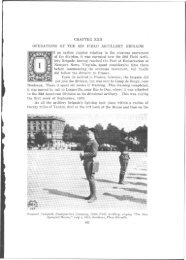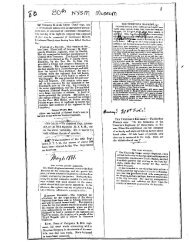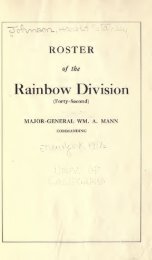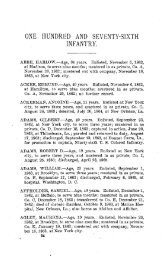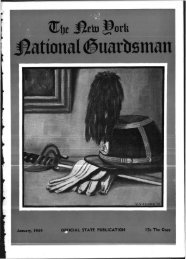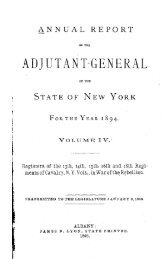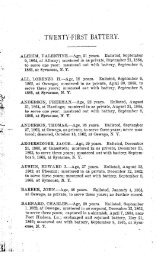July - DMNA - New York State
July - DMNA - New York State
July - DMNA - New York State
Create successful ePaper yourself
Turn your PDF publications into a flip-book with our unique Google optimized e-Paper software.
18 THE NEW YORK NATIONAL GUARDSMAN <strong>July</strong>, 1936<br />
PILOTLESS PLANES FOR BRITAIN<br />
-NTI-aircraft batteries in England no longer fire at<br />
sleeves or "kite" targets towed by an airplane, but<br />
carry out their firing practice on real planes that fly<br />
themselves without anyone aboard them.<br />
These realistic targets are small radio'controlled planes<br />
which take off, maneuver, and land under the control of<br />
radio operators stationed on the ground. Known as<br />
"Queen Bees," they have been in use in the British Navy<br />
for the past three years and are now being adopted by the<br />
British Army for antiaircraft practice.<br />
When there were but few of these "Queen Bees," any<br />
suitable cruiser in which the necessary radio apparatus<br />
had been installed was used as a home base for them;<br />
but now that their number has increased and the firing<br />
practices become so frequent, a special tender has been<br />
designed for them which will carry a permanent staff of<br />
markers in charge of the machines for recording the fire<br />
and bursts.<br />
It will be possible to store at least a squadron of these<br />
machines in the hold of each tender, and the necessary<br />
equipment with which to service them.<br />
The "Queen Bee" is a De Havilland "Tiger Moth 1 '<br />
plane (similar to that flown by King Edward VIII when<br />
he was Prince of Wales for his own use), redesigned in<br />
certain particulars to enable it to fly itself. One of the<br />
features of this plane is the silent operation of its 8-inline,<br />
inverted, air-cooled engine.<br />
Although, at present, it performs the single function<br />
of being a target, the Royal Air Force is enthusiastic in<br />
its possibilities and is experimenting in secret to develop<br />
its wider potentialties. At present, these radio-controlled<br />
planes are slow and possess a limited range of action.<br />
But the veriest layman can realise that these limitations<br />
are merely temporary and will soon be overcome. Larger<br />
Wide World Photo<br />
Informal Study of a Marshal<br />
Marshal Badoglio, leader of the Italian forces in Ethiopia, was<br />
caught by this photographer brooding over his plans as he<br />
watched a motorized column making its way towards Addis<br />
Ababa. The picture was flown from Addis Ababa to London,<br />
flown from London to Fran\fort where it was placed on the<br />
Hindenburg and flown to La\ehurst, l^ew Jersey.<br />
machines could very profitably be used as bombers, or<br />
equipped with an automatic camera for photographic<br />
reconnaissance. Modern airplanes, placed in mass production<br />
(as they would be in another great war) could<br />
be turned out and replaced in much shorter time than it<br />
would take to train pilots to man them. And, free from<br />
the vulnerability of a human pilot, they would be more<br />
difficult to put out of action.<br />
Remote radio control, as applied to means of locomotion,<br />
is still in its infancy, but doubtless a time is coming<br />
when tanks, airplanes, maybe even battleships and<br />
submarines, will be included in the Robot category. Yet,<br />
even when we have all those appliances, the final assault<br />
on a position will still be made by the Infantry—on foot.<br />
This superb photograph of the S.S. "Queen Mary" was made by the 102nd Photo Section of the 27th Division Aviation, H-Y-H-G.,<br />
as the great vessel steamed slowly up the Harrows on her maiden trip to Hew Tor\. We hope to publish further samples of the<br />
, ; i". 102nd Photo Section's excellent wor\ in the near future.


